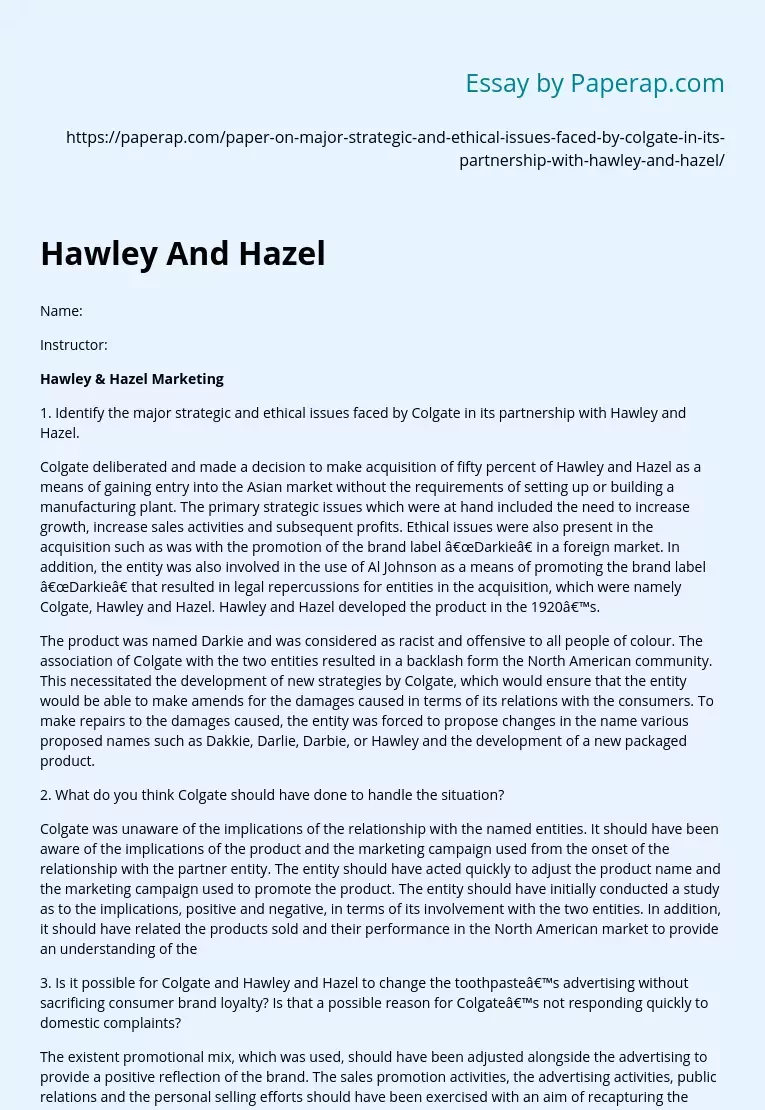Hawley & Hazel Marketing
Identify the major strategic and ethical issues faced by Colgate in its partnership with Hawley and Hazel.
Colgate deliberated and made a decision to make acquisition of fifty percent of Hawley and Hazel as a means of gaining entry into the Asian market without the requirements of setting up or building a manufacturing plant. The primary strategic issues which were at hand included the need to increase growth, increase sales activities and subsequent profits. Ethical issues were also present in the acquisition such as was with the promotion of the brand label “Darkie” in a foreign market.
In addition, the entity was also involved in the use of Al Johnson as a means of promoting the brand label “Darkie” that resulted in legal repercussions for entities in the acquisition, which were namely Colgate, Hawley and Hazel. Hawley and Hazel developed the product in the 1920’s.
The product was named Darkie and was considered as racist and offensive to all people of colour.
The association of Colgate with the two entities resulted in a backlash form the North American community. This necessitated the development of new strategies by Colgate, which would ensure that the entity would be able to make amends for the damages caused in terms of its relations with the consumers. To make repairs to the damages caused, the entity was forced to propose changes in the name various proposed names such as Dakkie, Darlie, Darbie, or Hawley and the development of a new packaged product.
What do you think Colgate should have done to handle the situation?
Colgate was unaware of the implications of the relationship with the named entities.
It should have been aware of the implications of the product and the marketing campaign used from the onset of the relationship with the partner entity. The entity should have acted quickly to adjust the product name and the marketing campaign used to promote the product. The entity should have initially conducted a study as to the implications, positive and negative, in terms of its involvement with the two entities. In addition, it should have related the products sold and their performance in the North American market to provide an understanding of the
Is it possible for Colgate and Hawley and Hazel to change the toothpaste’s advertising without sacrificing consumer brand loyalty? Is that a possible reason for Colgate’s not responding quickly to domestic complaints?
The existent promotional mix, which was used, should have been adjusted alongside the advertising to provide a positive reflection of the brand. The sales promotion activities, the advertising activities, public relations and the personal selling efforts should have been exercised with an aim of recapturing the market share and growth in the future. The use of a proactive strategy would have provided the entity with the ability to manage the issue. Such issues should have been evaluated and anticipated by the management with an aim of ensuring that the needs of the consumers were respected.
in the end, was a “no management rights” clause good for Colgate? What could have happened during the negotiations process to get around this problem?
The use of the “no management rights clause” was inappropriate for the organisation. The entity should have maintained rights of management of the brand. This would have provided Colgate with an opportunity to use such as a means of managing the sales and marketing process and strategies used for the product brands.
The acquisition should have prompted Colgate to acquire the management rights given that; it had attained a 50% ownership of the entity.
This translates to granting the entity exclusive rights in decision-making processes of the merger organisation. The entity should have ensured that it was to acquire management rights due to its acquisition of the larger controlling part of the organisation, in comparison to the other entity, that could be termed as minor partner in the merger. In addition, the entity, Colgate should have ensured that the two entities actualised their corporate social responsibilities and operated with provided levels of standards of ethical and moral conduct in the market. This would have ensured that there was absence of such incidences, which were primarily viewed as racist by consumers.
Hawley & Hazel Marketing. (2019, Dec 05). Retrieved from https://paperap.com/paper-on-major-strategic-and-ethical-issues-faced-by-colgate-in-its-partnership-with-hawley-and-hazel/

